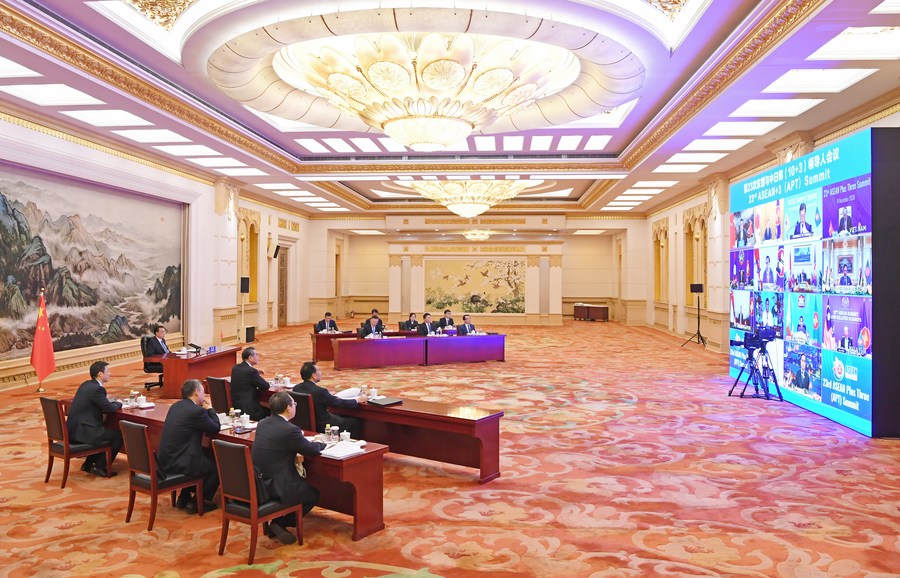
Chinese Premier Li Keqiang attends the 23rd leaders' meeting of the Association of Southeast Asian Nations (ASEAN) plus China, Japan and the Republic of Korea (ROK) (ASEAN Plus Three), which is held via video link, at the Great Hall of the People in Beijing, capital of China, Nov 14, 2020. [Photo/Xinhua]
This is an editorial from China Daily.
The signing of the Regional Comprehensive Economic Partnership offers a badly needed boost to regional economic confidence, and may serve as a crucial first step toward the redrawing of the global economic map over time.
As such, the deal has historic implications not only for the 15 signatories — the 10 members of the Association of Southeast Asian Nations, Australia, China, Japan, New Zealand and the Republic of Korea — but also potentially the world.
Covering a combined population of 2.1 billion and accounting for nearly 30 percent of global GDP, the RCEP is the largest trade pact the world has ever seen – bigger than both the US-Mexico-Canada Agreement and the European Union single market.
Although it does not go as far as the European Union in integrating member economies, for its commitment to progressively lower tariffs between the member economies alone over the coming years, a free trade deal of such a scale will provide enormous momentum to regional trade. Not to mention the hopes it embodies for countering protectionism, boosting investment, opening up the trade in services and allowing freer movement of goods within the region.
The deal may in turn provide substantial assistance to the post-pandemic recovery of the signatory economies.
The heavy blow dealt to regional economies by the novel coronavirus added to the signatories' sense of urgency and facilitated the ultimate signing of the agreement.
Although nothing should blind us to the hurdles the RCEP faces ahead, what was accomplished on Sunday was ultimately an opening move toward a more promising future for the region.
But the parties to the agreement should be aware that any attempt to add geopolitical baggage to the essentially economic grouping will only end up disrupting its functioning.
It is misleading to portray it as a China-led alternative to the now-defunct US proposed Trans-Pacific Partnership, as some are already trying to frame it.
On the one hand, Beijing's enthusiastic support for the RCEP doesn't mean Beijing is leading it. Its formulation and future operation is and will be a process of consensus-based coordination and collaboration.
On the other hand, despite the US withdrawal, the Comprehensive and Progressive Agreement for Trans-Pacific Partnership is alive and well as a reincarnation of the TPP.
There must always be a clear understanding that what drew the 15 countries together was common trade concerns, rather than political beliefs and broader values. Giving it geopolitical connotations will only prove divisive, now and in the future.
If concerns over the uncertainty in US domestic politics and the next US administration's approach to the Asia-Pacific were factors facilitating Sunday's signing of the RCEP, it is probable that these will inevitably loom larger as time goes by.
Like it or not, the RCEP won't operate on its own in an international political vacuum. Nonetheless, the realization of the RCEP is a landmark achievement of East Asian regional cooperation, and a victory for multilateralism and free trade against the forces opposing them.

 中文
中文



